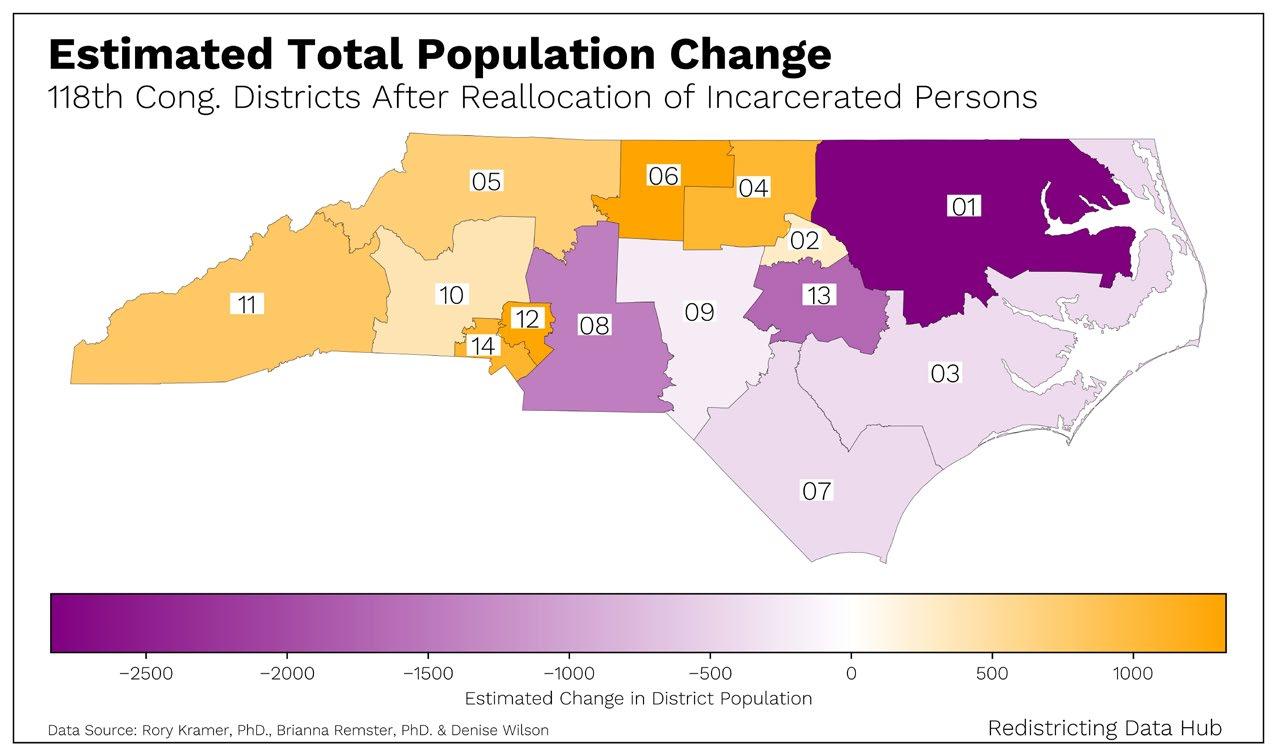Prison Gerrymandering:
How One Count Leads to a Decade of Distortion









“One-person, one-vote” is the principle of equal representation, which says each voting district must have the same total population, within one person. If districts had different amounts of people, then the residents of less-populated districts would have disproportionately more representation than higher-populated districts.
Think about it this way: District A has a population of 10 people, and District B’s population is five. A resident of District B makes up a greater share of their district (1 in 5 or 20%) than a resident in District A (1 in 10 or 10%). That wouldn’t be fair. Under “one-person, one-vote," each person must make up the same share of their district as anyone else.


To make sure voting districts contain the same number of people, the redistricting process uses Census data, which is the official “count” of the population that the U.S. government conducts every 10 years.
The Census counts people at their “usual residence,” which the Bureau considers to be where we live and sleep most of the time.
A person’s “usual residence” is unclear in various situations. For example, where should military service members be counted if they are deployed or stationed away from “home” on Census Day? What about truck drivers, Congress members, or boarding school students?
The Census counts service members who are deployed or stationed abroad at their usual residence in the United States. Boarding school students are counted at their parents’ or guardians’ home, even though they may be at school on Census Day. Truck drivers and Congress members are also counted at their usual residence in their home communities.
By contrast, the U.S. Census currently counts people who are incarcerated on Census Day at the local, state, or federal correctional facility they’re held in rather than their home communities, where they will most often return upon release. In contrast to their boarding school peers, youth held in juvenile correctional facilities are not counted at their parents’ or guardians’ home.
The Census Bureau counts incarcerated people this way despite the fact that most state constitutions and statutes explicitly say incarceration does not change a person’s legal residence. Furthermore, incarcerated individuals often lack constituent relationships with the elected officials serving the district where they are incarcerated*.
It is clear that while the Bureau uses time spent in a location as a starting point for applying residence criteria, there is recognition of the importance of family and community ties in determining how to count people who are away from home. The Bureau, though, does not extend this consideration to people who are incarcerated.
Before the 2020 Census, the Bureau accepted public comments related to the residence criteria.
People made almost 78,000 public comments about incarcerated people, and more than 99% called for them to be counted in their home communities.
The Census did not make this change.
* In North Carolina, people serving sentences for felony convictions are prevented from voting.
*In North Carolina, people serving sentences for felony convictions are prevented from voting.
Prison gerrymandering is the distortion to representation that occurs when voting maps are drawn using Census numbers that count incarcerated individuals where they are temporarily displaced instead of their home communities. Prison gerrymandering can happen in redistricting processes for states, cities, school boards, or other local governments. It is most consequential at the local level where districts are smaller in population and each person makes up a bigger share.
When officials prison gerrymander, any district with a correctional facility will have fewer true residents than a district without. This distortion transfers political power to people who live near prisons and away from people and communities impacted by incarceration.
Think back to our two hypothetical districts, except now Districts A and B each have populations of 10 people. Three of District A’s residents are incarcerated, so there are only seven true constituents in District A. They make up a bigger share of their district than a resident in District B where all ten people are true residents.
Prison gerrymandering distorts local voting districts and means that our elections do not accurately assess the will of the residents in a particular county. This is a widespread, yet easily fixable, problem that we can and should address.
—
HILARY HARRIS KLEIN, SENIOR COUNSEL FOR VOTING RIGHTS AT SCSJ

The Redistricting Data Hub analyzed the impact prison gerrymandering has on population counts in North Carolina’s 118th Congressional Districts. They found that prison gerrymandering overinflates District One by approximately 2,837 people. Meanwhile, District Six lost approximately 1,329 people to the practice. A resident in District One, therefore, has enhanced representation compared to someone in District Six.
In addition to distorting population size, prison gerrymandering misrepresents the demographics of a district’s population. According to the Redistricting Data Hub’s analysis, District 11’s population would see an increase in its white population and a slight decrease in Black population if people in prison were reallocated.



Note: RDH’s analysis is based on reallocation of people in state correctional facilities; it does not include people who are incarcerated at local jails, juvenile facilities, or federal facilities, all of whom the Census counts at those facilities.


1 2 3
People who are incarcerated, and their communities, are misrepresented until the Census Bureau conducts another count in 10 years.
• Since Black and Latine communities are disproportionately impacted by mass incarceration, prison gerrymandering exacerbates their systematic underrepresentation.
• Urban areas are particularly impacted because they have historically had much higher incarceration rates than their rural counterparts.
People who live near correctional facilities have enhanced representation. These facilities are typically located in more white, rural areas.
• Although residents benefit from disproportionate representation, these districts are at risk of dysfunction. Once in power, elected officials are not as incentivized to be responsive representatives. Furthermore, if the district has a small number of true residents and elections are determined by only a few votes, then individuals can more easily obtain power and entrench themselves in it through write-ins or other means.
Residents of districts that don’t include a correctional facility are underrepresented compared to residents of those that do.
People deserve equal representation and fair maps that reflect genuine constituent relationships between residents and their local elected officials. Prison gerrymandering prevents fair representation and undermines our democracy by distorting voting maps and transferring incarcerated people’s political power to people who live near prisons.
There is a growing movement to change the way incarcerated people are counted in redistricting and in the Census. State and local governments increasingly want to end prison gerrymandering but are frustrated by obstacles they encounter that could easily be addressed by the Census Bureau. Many rural counties with large prisons even see prison gerry-mandering as an obvious problem in need of solving. More than 200 local governments have already taken action to avoid prison gerrymandering by excluding non-resident prison populations when they draw districts.

Excluding incarcerated populations is an imperfect fix, though. This solution is only effective to rectify the harm to districts that don’t have correctional facilities. It does not improve at-home representation for incarcerated people or rectify the harm to their communities. Furthermore, this piecemeal solution depends on local governments to know this is an issue and to take on the administrative burden of modifying U.S. Census data during the redistricting process.
In 2010, Granville County, North Carolina’s Commission District 3 was drawn such that incarcerated people made up 40% of the district. Including the prison populations meant that a resident in this district had almost double the representation of residents in other districts. People in Granville’s remaining six districts were comparatively underrepresented in the Board of Commissioners.

After a concerted effort by a coalition of pro-democracy groups in 2021, the Granville County Commission stopped prison gerrymandering for the first time in known history by excluding the county’s non-resident prison populations in their population count for redistricting purposes.
Bottom line: Only national action can completely remedy prison gerrymandering by changing the Census to count incarcerated people at their last place of residence in the communities where they are likely to return once released.
The Southern Coalition for Social Justice, founded in 2007, partners with communities of color and economically disadvantaged communities in the South to defend and advance their political, social, and economic rights through the combination of legal advocacy, research, organizing, and communications. Learn more at southerncoalition.org and follow our work on Twitter, Facebook, and Instagram.
Media Contact: Media@scsj.org

NC Counts Coalition is a nonpartisan, nonprofit 501(c)(3) organization committed to building a healthy, just, and equitable North Carolina through cross-sector partnerships that advance systemic solutions for communities facing systemic barriers, including BIPOC communities, LGBTQ+, low wealth, immigrant, and other communities.

The non-profit, non-partisan Prison Policy Initiative produces cutting edge research to expose the broader harm of mass criminalization, and then sparks advocacy campaigns to create a more just society.

The nonpartisan Redistricting Data Hub was founded by experts with backgrounds in pioneering redistricting legal cases, the establishment of independent redistricting commissions, and related ballot initiatives in Florida, Arizona and other states. Our mission is to provide individuals, civic organizations, and good government groups the data, resources, and knowledge to participate effectively in redistricting processes by learning how to define their communities, provide meaningful public input, recognize gerrymandering, and advocate for fair and legal maps.
Image produced by Peter Horton, Data Analyst at the Redistricting Data Hub. Thanks to Rory Kramer, PhD, Brianna Remster, PhD, and Denise Wilson for contacting the North Carolina Department of Public Safety to retrieve the raw data and performing the processing to create the estimates used in this image.